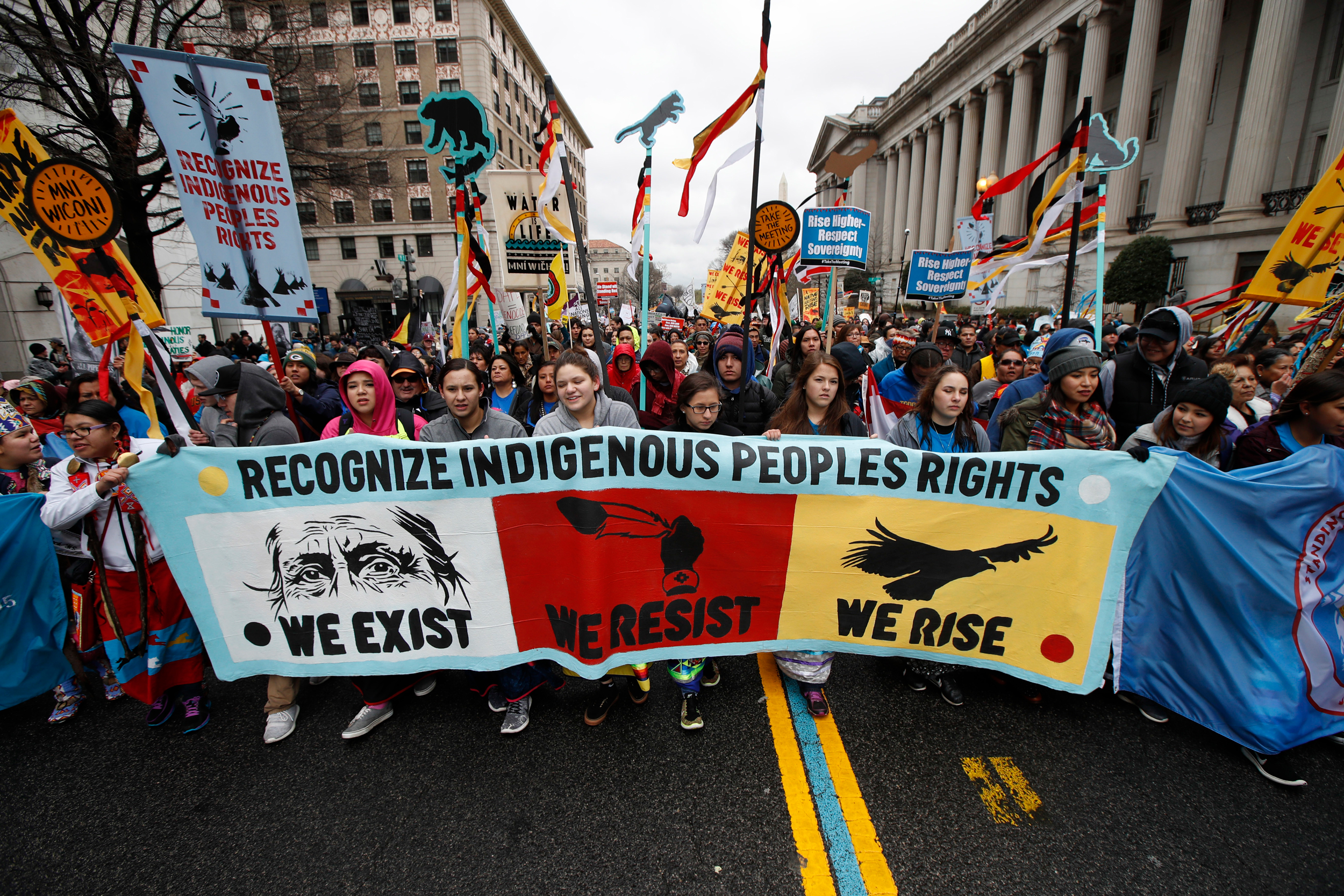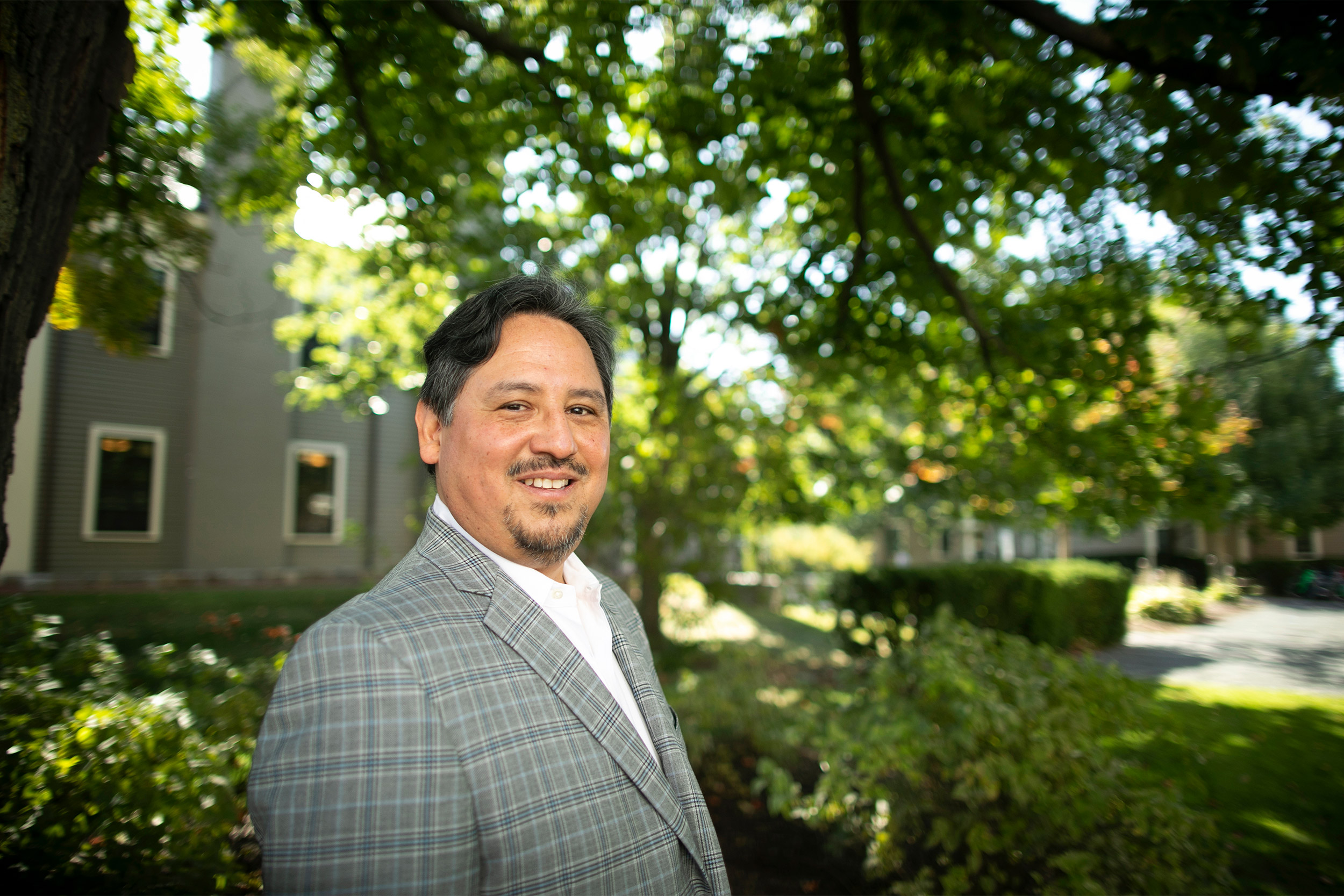
Native Americans and their supporters march toward the White House in March 2017, to rally against the disputed Dakota Access pipeline.
AP Photo/Manuel Balce Ceneta
Another long-overdue reckoning for America
Examining what Supreme Court ruling, NFL team name change mean for Native peoples
After a narrow 5-4 vote, the U.S. Supreme Court issued a landmark ruling this month declaring that a large portion of eastern Oklahoma remains Native American land. The McGirt v. Oklahoma decision, written by Justice Neil Gorsuch, upheld the rights of the Muscogee (Creek) Nation to govern its lands and affirmed tribal sovereignty and treaty rights. Days later, the NFL franchise in Washington, D.C., decided that it would drop the team name of Redskins, which Native Americans have long criticized as racially offensive and demeaning. We asked members of the Harvard community to reflect on the significance of these developments, which come amid the wider national reckoning on the historical mistreatment of communities of color.
Shawon Kinew, A.M. ’12, Ph.D. ’16
Citizen of the Ojibways of Onigaming First Nation, Treaty 3 Anishinaabe Nation
Assistant Professor of History of Art and Architecture
Shutzer Assistant Professor at the Radcliffe Institute for Advanced Study

Stephanie Mitchell/Harvard file photo
This is a moment to reckon with the history of American land, how it was seized, how it was tilled, and the human toll of these practices.
When George Floyd was murdered by police officer Derek Chauvin, this injustice was carried out in Minneapolis, on Ojibwe and Dakota land, not far from where President Lincoln hanged 38 Dakota men in 1862. This is a city that benefits daily from its most famous son, Prince, one of the great American artists of all time, a Black man. There is something of an allegory for America in Minneapolis. This is a place that could not be without stolen land, genocide, slavery, and without the contributions of Black and Indigenous Americans.
In both the NFL and Oklahoma, Black and Indigenous presence and histories intersect. The Washington football team and Supreme Court decisions are the result of decades of activism, born of the American Civil Rights Movement that brought Black and Indigenous peoples together.
In this confluence of events in 2020 is a call for greater historical consciousness, to understand North America’s violent history and its living legacy, from slurs that dehumanize to the ongoing denial of fundamental rights — human rights, treaty rights. It is a particularly important moment to honor and celebrate Black Natives, whose identities and histories are often erased.
Tiya Miles ’92
Professor of History, Harvard University, whose work explores the intersections of African American, Native American, and women’s histories
Radcliffe Alumnae Professor, Radcliffe Institute for Advanced Study

Stephanie Mitchell/Harvard Staff Photographer
Over the chaotic weeks of this summer, a monster convergence of societal betrayals propelled millions of Americans into the streets. Those betrayals included most prominently the graphic killings of George Floyd, Breonna Taylor, and many more African American victims of police and vigilante brutality. The truly multiracial nature of the protests has been a heartening element even amid a complicating public health crisis and a shocking reactive display of police and military force. Indeed, this moment has highlighted interconnections between the histories and experiences of people of color. Native Americans across the country were among those marching with Black Lives Matter signs. Calls for justice for Black people expanded into public outrage at the treatment of Indigenous people in the U.S. in a way that has finally produced a major reversal in the long battle to banish pejorative sports team mascots.
Racism against African Americans and Native Americans often takes different forms, and stereotypes about each population have divergent histories and motivations. Yet, dehumanizing caricatures of the wild “savage” or dangerous “predator” surely affect the disproportionate rates of arrest, physical abuse by police, and incarceration faced by both African Americans and Native Americans.
Open disparagement of Black people and Black culture has been so widespread, egregious, and ugly in this country, and the movement against it so broad and forceful, that cultural norms shifted over time to suppress practices like blackface. In contrast, the damaging romanticization of Native people, particularly in the 20th century, led to a mainstreaming of Native cultural appropriation and mischaracterization that many non-Native people refused to recognize as harmful. The intense pressure brought to bear on the Washington, D.C., sports team as part and parcel of an anti-racist message has exposed this practice as not only unethical, but also unacceptable to a vocal public.
The incredible legal decision that we also saw this summer in McGirt v. Oklahoma unfolded in a distinct domain, and I leave it to future scholars with the benefit of hindsight to work out how this particular social movement might have affected governmental outcomes.
The Supreme Court upheld Muscogee (Creek) tribal rights to govern their own lands within broad, legally stipulated boundaries previously ignored by the state of Oklahoma. In the 5-4 majority opinion written by Neil Gorsuch, the justices argued not only for upholding Native American territorial rights but also the rule of law. The Muscogee (Creek) Nation that relocated to the plains during the period of Indian Removal predates the state of Oklahoma (which only came into being in 1907), and has a preexisting treaty with the United States that includes congressionally approved boundaries.
The Supreme Court ruled that Oklahoma’s mere existence did not override that treaty. This is a tremendous victory for Indigenous rights to self-governance, and yet, as legal scholars and historians such as Stacy Leeds (Cherokee), Nick Estes (Lakota), and Matthew Fletcher (Anishinaabe) have pointed out, cautious optimism is warranted. Congress has the authority to create new legislation addressing this issue, and the federal government has been inconsistent at best when it comes to protecting the sovereignty of Indigenous nations within its borders.
Philip J. Deloria
Dakota descent
Professor of Native American and Indigenous Studies, Department of History

Rose Lincoln/Harvard file photo
The decisions of the Washington NFL team and the U.S. Supreme Court (and, I would add, U.S. District Court shutdown of the Dakota Access Pipe Line pending environmental review) remind us of the important links between culture and politics, and the need to contest both.
For centuries, Native people have insisted on the legal and contractual nature of treaties, and the Gorsuch opinion makes it clear that, even if inconvenient for white Americans, treaties are indeed the law of the land, and tribal governments are political sovereigns in their own right.
For decades, Native people have insisted that demeaning stereotypes have negative effects on American Indian children and culture, that the function of a sports team is not to “honor” anyone, and that Native mascots enact a unique kind of damage that is unimaginable when applied to another other racial or ethnic groups. In the middle of a long-overdue awakening to the realities of systemic racism in the United States, these changes and decisions are reminders that there are multiple histories that require some kind of reckoning.
Joseph P. Gone ’92
Aaniiih-Gros Ventre, Fort Belknap, Mont.
Professor of Anthropology and of Global Health and Social Medicine
Faculty Director, Harvard University Native American Program

Stephanie Mitchell/Harvard file photo
As a former doctoral student at the University of Illinois in Champaign, where the sports team mascot Chief Illiniwek danced at halftime throughout all my years on campus, I know the importance of retiring these harmful racial stereotypes.
Now comes the welcome news that the granddaddy of them all, the Washington R*dsk*ns, exists no more. It has been a long battle, which I first became aware of when the Cheyenne-Muscogee activist Suzan Shown Harjo visited Harvard during my undergraduate years. In the ensuing decades, while painted and feathered fans whooped and chopped in stadiums across America, mascots like these have depressed American Indian student self-esteem and foreclosed on our imagined futures.
And yet, robust visions of Indigenous futurity are even more in need now that half the state of Oklahoma has been re-recognized as tribal territory. The Harvard Charter of 1650 dedicates our University to the “education of the English and Indian youth of this Country.” Let us recommit campus-wide to promoting Native American and Indigenous education, community, scholarship, and inclusion.
Sarah Sadlier, J.D. ’22, Ph.D. ’23
Minneconjou Lakota
Co-President of the Harvard Native American Law Students Association

It is an exhilarating moment to be a Law School student working in Federal Indian Law. One of my favorite lines of the McGirt v. Oklahoma opinion is: “Unlawful acts, performed long enough and with sufficient vigor, are never enough to amend the law. To hold otherwise would be to elevate the most brazen and longstanding injustices over the law, both rewarding wrong and failing those in the right.” When you read this decision’s powerful language, you dare to hope that the United States will start following its own laws and honoring the treaties that it made with Native nations. This success energizes you to keep fighting to ensure that it does.
I continue to be inspired by the Indigenous women like Suzan Shown Harjo and Amanda Blackhorse, who have dedicated decades of their lives to combating racist mascots through the court system and beyond.
Anna Kate Cannon ’21
Citizen of the Choctaw Nation
Co-president of Natives at Harvard College

I’ve never liked the Washington Redskins team because they have been using a racial slur as their team name and profiting off of it for years. What troubles me is that not only the team, but a lot of people didn’t consider it a racial slur. Many people don’t see it as derogatory to Native people because they don’t believe that Natives are still here and have valid political claims. You see this all the time in politics, in statistics, etc. Natives are just glossed over.
Now many people recognize that the team was wrong, but the team has been wrong for so long, and what they did was extremely overdue. It’s kind of infuriating to see them being praised for something they should have done long ago. But we have to acknowledge that this change is a result of the pressure from the Black Lives Matter movement and the activism of Indigenous people, who have fought for years and years to remove the name. For me, this a clear representation of the fact that Black liberation and Indigenous sovereignty are always going to be tied together, and that we have to work together to demand equal treatment as people and as citizens.
As far as the McGirt v. Oklahoma decision goes, on one hand, it is monumental. The U.S. has entered into over 500 treaties with Native tribes throughout the centuries and has broken every single one of them. Now we have a decision from a conservative justice saying that the U.S. needs to uphold treaties, and included an iconic line written by Justice Gorsuch, “At the end of trail of tears, there was a promise.” There were so many promises and the U.S. broke every single one of them.
On the other hand, the Gorsuch decision has a caveat because it says that states do not have the rights to infringe upon or disestablish a reservation within their state boundaries, but that Congress still has the right to do both of those things. That is very scary especially because there are a lot of economic interests, oil and mining interests, in Oklahoma, and in Indian country, in general. But overall, this ruling is very encouraging because the history of federal Indian policy is just blow after blow to tribal sovereignty. Maybe there will be some turning point because Native sovereignty has definitely entered the national conversation.
Madison Esposito, M.P.H. ’21
Citizen of the Tyme Maidu Nation

Allyship is imperative to the longevity and effectiveness of any social movement. The allyship seen between Black and Native peoples living in what is now known as the United States of America has played no small part in building the social pressure necessary to cause the D.C. football team to finally change their team name. The name has always been seen as a slur and has been connected with real mental health impacts among Native peoples.
This is not to say that the social momentum we are seeing and experiencing in Indian Country is completely due to the support and attention we have amassed in our allyship to the Black Lives Matter movement. Each and every bit of progress and victory seen in Indian country, from the return of stolen land to the Cherokee, Muscogee, Seminole, Chickasaw, and Choctaw Nations, to a Native person living a fulfilled, healthy, and happy life, has been built on generations of Indigenous resilience, resistance, and resourcefulness.
We are here because our ancestors never stopped believing in the next generation. Continuing to move forward and improving Native lives requires following the practices of our ancestors and holding [that] relations are powerful and sacred. We do this by empowering ourselves and empowering the peoples we share this land with.
Eric Henson, M.P.P. ’98
Citizen of the Chickasaw Nation
Adjunct Lecturer in Public Policy, Harvard Kennedy School of Government

Both are important symbolic developments. But I’d like to temper the positive symbolism of these developments with the following caveats: Both decisions leave a lot on the ground unaddressed.
In the case of the Washington Redskins, the name change is in some ways diminished because it was done because the team’s ownership felt they were boxed in by changing tides and changing events. That’s pretty disappointing, because maintaining racist stereotypes should be undone on the principle of the matter and because it’s the right thing to do for the good of humanity.
Secondly, if a team wants to actually engage in a meaningful change, it could do much more than just change its logo. Sports teams, and not only in the NFL, could start engaging their legal counsel to issue cease-and-desist orders for people selling racist paraphernalia. They could begin mandating that their fans who come to their stadium don’t engage in racist chants, or racist activity such as the “Tomahawk chop” and whatnot. That, to me, would be putting some actual muscle behind this symbolic change of the team’s logo and mascot.
I have a similar set of caveats on the Supreme Court decision. Treaties that tribes have entered into have been ignored in many instances, and this wonderful legal development may mean that they will be less ignored going forward. My caveat is this: On the ground, how is it going to play out? The ruling itself is very narrow, and it might imply the shift to federal prosecution of major crimes committed by Indians, which could be worrisome. Just because the federal government has the right to prosecute major crimes in Indian country, it often does not. Some significant proportion, 39 or 40 percent, of possible prosecutions referred to the federal government in Indian country are not followed up on at all, and 25 percent of those have to do with violence against women.
It would be a real shame if specific action such as protecting Indian women who are assaulted, or are disappearing, or are being killed and murdered, actually gets worse in half of Oklahoma because now the prosecution of some of those crimes is much more in the ballpark of the federal government instead of local and state authorities. While it is definitely true that this Supreme Court ruling is a great development in Indian history, we all need to be diligent and make sure that the prosecutorial powers of the federal government are brought to bear to protect vulnerable people of all sorts; in the example we have been talking about, Native women who are victims of major crimes, in particular.
Megan Hill
Citizen of the Oneida Nation of Wisconsin
Program Director, Harvard Project on American Indian Economic Development

Photo by Megan Hill
The Black Lives Matter movement has awakened a new momentum across Indian Country. Last week, not only was the decades-long fight to remove the racist mascot from the Washington football team successful, but, in a landmark decision, the Supreme Court affirmed the treaty rights of the Muscogee (Creek) Nation, profoundly impacting law and policy for tribal nations across the U.S.
In different ways, both instances recognize Native peoples as contemporary peoples with contemporary governments, not as stereotypes or relics of the past. While these are important victories, the need to dismantle systemic racism and the erasure of Indigenous voices in institutions, like Harvard, continues. I stand in solidarity with my Black Lives Matter allies to address this racism and build new and inclusive systems that realize a collective, equitable future.




